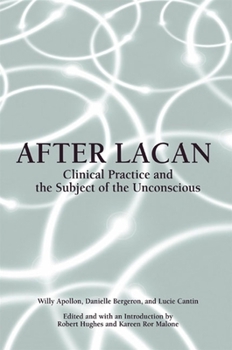After Lacan: Clinical Practice and the Subject of the Unconscious
The authors use examples from their own clinical practice to explain the development of Lacanian theory.
Format:Paperback
Language:English
ISBN:0791454800
ISBN13:9780791454800
Release Date:October 2002
Publisher:State University of New York Press
Length:208 Pages
Weight:0.65 lbs.
Dimensions:0.5" x 6.0" x 9.1"
Customer Reviews
2 ratings
A helpful map through Lacan's works.
Published by Thriftbooks.com User , 19 years ago
As a clinician who has both struggled to treat psychotic patients and struggled as well with Lacan's dense texts, I found "After Lacan" to occupy a unique place among the many books about Lacan. It is hardly a "quick read" - but given the depth and breadth of the field the authors explore together - it could hardly be expected to be. As the book's introduction reveals, Drs. Apollon, Bergeron and Cantin have long collaborated in interweaving theory and practice - an effort that led to the founding of both a school and a treatment center for psychotics. I found a receptive considered reading of their well crafted explanations to clarify many difficult concepts, such as jouissance, letter-of-the-body and the signifier. The inclusion of clinical vignettes brings these otherwise abstract concepts to life. Their broad approach thus lays out the dynamics of each of Lacan's structures: psychotic, perverse and neurotic. For me, their explication of the conduct of the treatment of the psychotic provided a much appreciated logical framework within which to work. One could say that they have fulfilled Freud's hope that one day an adequate treatment of the psychotic might be found.Charles Turk
A "Must Read"
Published by Thriftbooks.com User , 20 years ago
This is the best book I have read in my field in many years because it is both deeply clinical and theoretically sophisticated yet, at the same time, very readable. It was written for an audience already familiar with some of the fundamental concepts in Freud and Lacan. In that sense it's not an introductory text. It's especially delightful to read if you're familiar with Freud because the writers at once return to Freud and Lacan and push them further. Also, the book would be a challenge to read in the absence of this knowledge - not because the writing is cryptic or obscure but because it may confront the reader with pockets of ignorance. Nonetheless, the book is a good starting place for the novice because the writing is so accessible, even as it honors complexity. In short, I highly recommend this book for clinicians and theoreticians at every level.Many books claim to create a dialogue between theory and practice, but at best most just juxtapose the two. A huge strength of this book is that the authors actually link concrete clinical material with theoretical concepts. For example, Bergeron's clinical example on pages 65-67 of a psychoanalytic signifier is probably the clearest example I have ever read of this concept. Add to this clarity the poetics of someone who is also able to refer to the signifier as "the writing of a loss," (p. 61), and you will soon see that this book is a treasure.There are gems embedded in the text amidst larger arguments, but these gems are presented so unpretentiously that they might well go unnoticed. For example, Cantin refers briefly to adolescence as, "that time of life where revolt feeds on the discovery of the arbitrary and which also supports the accusation brought against the other as the one who hinders satisfaction." This incidental comment, so beautifully phrased, appears in the midst of an elegant clarification of the concept of desire.One of the great strengths of this book is the authors' clarity in presenting original ideas. My sense is that their ease in this regard results from two factors. First, the powerful and organizing introduction by Hughes and Malone points to three authors who do not work in isolation but rather in constant interaction with one another and with an entire school of analysts, students, and collaborators. Second, their thinking is grounded in their abundant experience in the clinic. As a result, their theoretical exposition feels embodied and vivid. Further, while the book is full of "understandings" that push my thinking further, it is also implicitly informed by a different kind of knowing: the "savoir" of the individual authors, that is, the particular knowing they have each articulated for themselves in relation to the things we cannot know. In a very immediate sense, this book prepares me to begin framing the question: how can we best succeed in living given the hardest human realities, namely, the inevitability of absence and death?Finally, in remarkably few pages the




